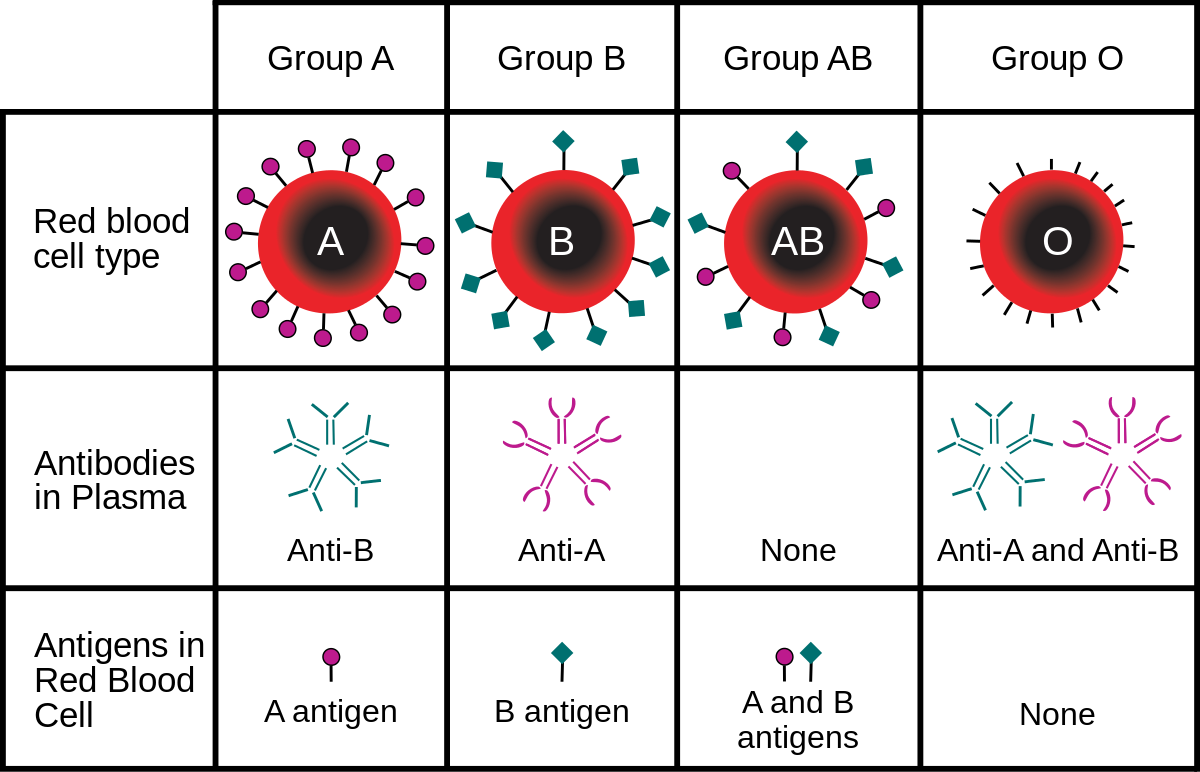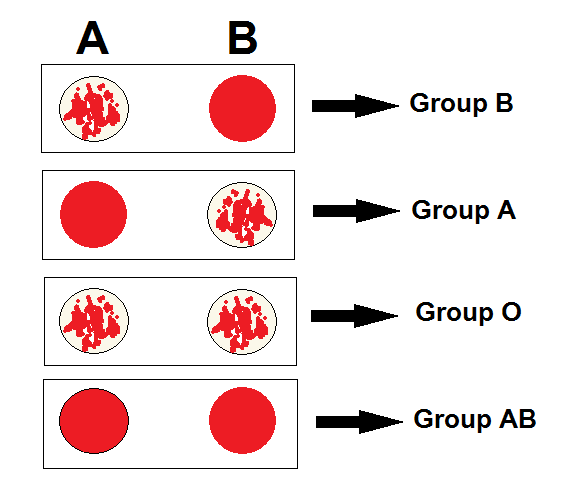
ABO grouping can be performed in two ways
Forward grouping/Cell grouping: Red blood cells are tested for A and B antigens using known anti-A and anti-B sera.
Reverse grouping/Serum grouping: Serum is tested for anti-A and anti-B anibodies using known A and B red cells.
Reverse Blood Grouping /Serum Grouping
Reverse blood grouping is a procedure to confirm ABO blood group based on the presence or absence of anti-A and anti-B in serum using known A and B red cells. It is cross check for forward typing. Performing both forward and reverse grouping provides a check for accuracy. Because of the lack of synthesized immunoglobulins, anti-A and Anti-B in newborns and very young infants, this procedure is not performed on infants below 4 months of age.
Principle
The reverse blood grouping procedure is based on the principle of direct hemagglutination. The erythrocytes of a person contain blood group antigens on the surface of the membrane. When these antigens are allowed to treat with corresponding antibodies, antigen-antibody reaction occurs and form agglutination.
Requirements
Specimen:
Serum is specimen for reverse blood grouping. No special preparation of the patient is required prior to collection. The specimen should be tested as soon as possible after collection, but specimens may be stored at 2 to 8?C if there is a delay in testing. Storage may result in weaker-than-normal reactions.
Cell Suspension:
Although red cell reagents for serum grouping are available commercially, most laboratories prepare their own A and B test red cells from persons known to be group A and group B. Make pooled cell suspension as follows:
- Label tubes as A and B.
Tube A: Place 1 drop of red cells each from 3 of A group samples.
Tube B: Place 1 drop of red cells each from 3 of B group samples. - Add Normal saline and to suspend the cells. Centrifuge the tubes for at least 1 minute at 1000 rpm. To make 5% red cell suspension, add 1 drop of RBC to 19 drops of saline. Make 20% suspension for slide method.
- Test the pooled cells prepared by adding the antisera (Anti-A, B) in use.
Procedure
The reverse blood grouping can be performed in two methods: Tube and Slide method. The Tube method is preferred to slide method.
Tube Method
- Label two test tubes as A and B.
- Add two drops of serum to be tested in each tube.
- Add one drop each of A and B cells suspension to the corresponding test tubes.
- Mix well and centrifuge both tubes at 1000 rpm for 1 minute.
- Gently remove the tubes and completely resuspend cells and examine macroscopically for agglutination and if negative, microscopically.
- Record the reactions and interpret the results.
Slide Method
- Mark a clean slide into two halves, labeling the left and right side side as A and B.
- Add a drop of serum to be tested on both sides.
- Add one drop each of A and B cells suspension (20%) to the corresponding sides.
- Using a clean applicator stick, mix the serum and cell suspension on both sides separately and spread into a smooth round circle.
- Rock the slide gently for 2 minutes and look for agglutination.
- Record the reactions and interpret the results.
Results and Interpretation
If agglutination is observed with A cells only, then the patient’s blood group is B
If agglutination is observed with B cells only, then the patient’s blood group is A
If agglutination is observed with both A and B cells, then the patient’s blood group is O
If agglutination is not observed with both A and B cells, then the patient’s blood group is AB

Limitations
- Serum from persons with agammaglobulinemia may not contain detectable ABO antibodies.
- As naturally occuring anti-A and anti-B are only formed 3-4 months after birth, it is not suitable for newborns and infants. Antibodies at this age are commonly of maternal origin.

Nice information. I will share with my students
Thank you Premkumar!
Nice buddy
what is advantages and disadvantages of tile methods and tube methods.
wow what a wonderful piece of lectures. I’ll share with friends I have around the globak
Thank you so much
All appreciation and thanks goes to you for helping me in my research . may the Almighty God continue to bless you with wisdom as we keep on sharing it.
THANKS
Can i get the procedure for PAPANICOLOAU STAIN(PAP SMEAR) pls help!
I need a proper SOP for ABO grouping on both forward and reverse method. Thanking in advance 🙂
I also want to know how you can interpret results of reverse grouping after knowing the blood group ,,then why could there be a reaction and why couldn’t there be a reaction.
Thanks after a long time without practice, I had trouble yesterday interpreting reverse grouping. Now I am up to date.
Alhamdulillah thanks goes to you too now I understand the reverse blood Grouping
Nice information keep it up!!!!!!
Mr. Dhurba indeed you’re brilliant,intellectual and vibrant Medical Laboratory Scientist,your blog is a blessing to not only i but to my students as well,i wish you more wisdoms in life Amen.
Please answer this question
1)forward group mixed field reaction in B cloumn indicating presence of both O and B red cells
2) reverse group only anti a present
3) RH type is Positive
This means what blood group?